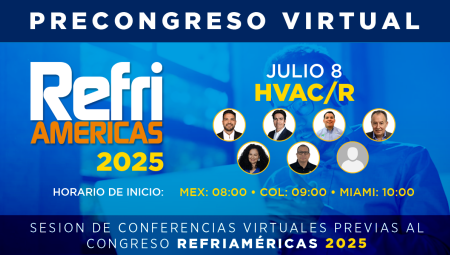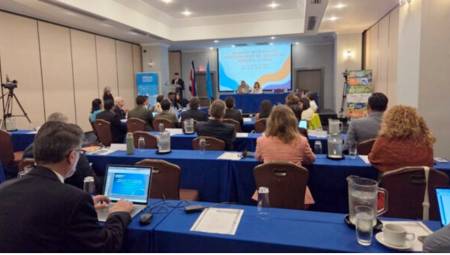Recovery, Recycling and Regeneration
 Gas Recovery, Recycling and Regeneration
Gas Recovery, Recycling and Regeneration
For many of those linked to the work of refrigeration and air conditioning, the effect caused by refrigerant gases to the atmosphere is well known, to which much of the blame for the hole in the ozone layer is attributed.
Substances such as chlorofluorocarbons (CFCs) and hydrochlorofluorocarbons (HCFCs), having chlorine, react with the ozone molecule producing a photochemical consequence in chain, which ends up breaking the ozone molecule.
This damage generated to a large extent by CFCs and HCFCs is due to bad practices carried out by technicians and professionals who for years and even today release refrigerant gases into the atmosphere because they do not know what to do with it.
But these bad practices are not only still implemented with these chlorinated gases, but also with the gases considered new generation such as R-410A, created to replace CFCs and HCFCs, thanks to the fact that their Ozone Depletion Potential (ODP) is zero, because it does not contain chlorine and therefore it is maintained that they are definitive refrigerants. However, it has Global Warming Potential (GWP) values, which implies an influence on the greenhouse effect.
There are also so-called ecological refrigerants such as hydrocarbons (HC), which are hydrocarbons, as well as Carbon Dioxide (CO2) and others.
Although the latter are called natural refrigerants because they remain in the atmosphere for a short time, their use is not yet widespread due to the technical and safety implications that it entails in systems based on these types of refrigerants.
However, it must be taken into account that regardless of the type of refrigerant gas used, it should be avoided to make negligent use of it by letting it escape into the atmosphere, since this layer of gas accumulates every day multiple particles of pollutants which make it difficult for part of the solar radiation received by the Earth, is re-emitted into space, so it remains in the atmosphere generating an overheating of the planet.
Regarding how harmful refrigerant gases can be, a series of policies and measures have been implemented that lead to reversing the damage generated by these substances.
In a world as innovative as the refrigeration and air conditioning industry, large companies in this sector of the economy have imposed norms and rules, which have permeated the political powers of various nations, making regulations regarding refrigerants have become law, which generate sanctions for all people who perform bad practices with these gases.
Because the HVAC&R industry cannot be finished since it occupies a fundamental part in the world economy and every day is more in demand, companies have put all the will of their knowledge and research to adapt to the environmental demands of the new times, for this reason they have applied considerable modifications to their products, making them more friendly to nature and energy efficient every day.
In the same way they have developed technologies that enable business continuity, one of these innovations is to have achieved the process of Recovery, Recycling and Regeneration (Reclaim) of refrigerant gas.
According to ASHRAE Guide 3-1990, the following definitions are available:
Recovery: Means removing the refrigerant gas, in any condition, from a system and storing it in an external container, without analyzing or processing it.
Recycle: It is to clean the refrigerant gas to reuse it, removing the oil or passing it through multiple devices, such as dehydrating filters, which reduce moisture, acidity and the presence of solids. This term is usually applied to procedures that can be implemented on-site or in the service shop.
Regenerate (Reclaim): It is the reprocessing of the refrigerant gas until it reaches the specifications of a new gas. This process uses distillation. A chemical analysis of the gas is required to determine that it reached specifications. Regenerating involves the use of processes and procedures that can only be executed on a reprocessor computer or at the manufacturer's plant.
All persons active in the HVAC&R industry have an obligation to protect the environment from emissions of chlorine-containing gases.
Considerations for the definition of Regenerate or Reclaim
Chemical analysis is a key procedure when regenerating gas. The phrase specifications of a new gas means to practice a chemical analysis to ensure that the purity specifications were reached in accordance with the ARI Standard 700. Despite having reached purity levels, after having reprocessed the gas, it can be said that the refrigerant was NOT regenerated, unless chemical analysis has been performed.
Recovery and Destruction: When a refrigerant recovered from refrigeration and air conditioning equipment is contaminated or mixed with other refrigerants, it is not feasible to recycle or regenerate it and therefore cannot be used again. The best option for a contaminated or mixed refrigerant is to send it to a process for final disposal and destruction.
There are currently many technologies for the destruction of refrigerants CFCs and HCFCs; these technologies were evaluated and approved by the Technical and Economic Assessment Panel (TEAP) of the Montreal Protocol. (Table 1)
Table 1. Technologies evaluated and approved by the TEAP for the destruction of CFCs and HCFCsRefrigerant destruction technology CFCs and HCFCs
Opinion on the assessment of the TEAP
Destruction and Disposal Effectiveness (EDE)**99.99%
Cement kilnsApproved
Liquid injection incinerationApproved
Oxidation of gases/fumesApproved
Reactor crackingApproved
Incineration in rotary furnaceApproved
Argon plasma arcApproved
Inductively coupled radiofrequency plasmaApproved
Microwave plasmaApproved
Nitrogen arcApproved
Catalytic dehalogenation in the gas phaseApproved
Superheated steam reactorApproved
Note: ** The EDE criterion refers to the capacity of the technologies on the basis of which that technology is approved. It does not always reflect the daily performance given, a factor that will be controlled by national minimum standards.The above processes are based on the treatment that must be given to CFCs and HCFCs, the most harmful refrigerants, which were already discontinued thanks to the fact that their manufacture was ceased, however in the world millions of teams persist that still use this technology since entering the use of R-410A implies the complete renovation of the refrigeration or air conditioning unit and therefore a cost significant for those who own these equipment. (Table 2)
Table 2. Refrigerant gases used to replace CFCs TRANSIENT REFRIGERANTS Refrigerant Replace Lubricant Review CFC R-12 AB or MIN HFC R-22 AB or MIN CFC+HCFC R-502 AB or MIN HCFC R-410A R-12 AB Easy change HCFC R-401B R-12 AB Easy change HCFC R-402A R-502 AB Easy change HCFC R-402B R-502 AB Only apply on ice cabling machines. Easy change HCFC R-408A R-502 AB Easy change HCFC R-409A R-12 AB Easy change CHLORINE-FREE REFRIGERANTS HFC R-134a R-12 POE Difficult change Not recommended in HFC R-404A R-502 POE hermetic compressor system Difficult change Not recommended in HFC R-507 R-502 POE hermetic compressor system Difficult change Not recommends in hermetic compressor system HFC R-407C R-22 Difficult change Not recommended in hermetic compressor system HFC R-410A R-22 POE It should not be done, because it works with a pressure higher than that of R-22 MIN: Mineral Oil; AB: Alkylbenceno Oil; POE: Polyolester OilFor this reason as a first step to mitigate the release of CFCs and HCFCs, whose chlorine destroys the ozone layer, it was proceeded to stop manufacturing it, however, as said above, the HVAC&R industry can not be stopped and while all people become aware and turn to the installation of environmentally friendly refrigerant equipment, all those related to refrigeration and air conditioning must look for alternatives, hence they are taking measures related to the recovery, recycling and regeneration of refrigerant gas.
In Europe and the United States, technologies for the treatment of gases have been widespread, since these regions are one of the most responsible for the release of chlorinated gases.
Following the framework of the Montreal and Kyoto Protocols, Mexico has ventured into the recovery, recycling and regeneration of refrigerant gases since May 2008, when 14 refrigerant treatment centers were opened throughout the country with the aim of having engineers, technicians and HVAC&R professionals execute good practices, since once the gas is recovered and stored, they can take it for regeneration in such a way that they can use it again.
RECOVERY TECHNOLOGIES
Since a recovery unit will allow more fluorocarbon-based refrigerant to be extracted from a system than any other method that can be used, its use should be considered the norm rather than the exception.
Contractors, technicians and equipment owners must ensure in advance that they will be able to have the necessary recovery equipment. Their availability, refinement, variety and demand are on the rise and this results in them being used more widely.
As with vacuum pumps, recovery units will operate more efficiently if the length of the connecting hoses is as short as possible and their diameter as wide as possible. A diameter of 3/8" for the hose should be the minimum measurement but preferably should be 1/2".
Either way, it should not be used as an excuse not to use a recovery drive simply because it cannot be placed close to the system. If longer hoses have to be used, all that will happen is that the recovery operation will take longer. There is no acceptable reason or excuse for letting fluorocarbon-based refrigerants escape into the environment.
METHODOLOGY FOR RECOVERING GASES
Refrigerant gas recovery is the initial phase to repair or service HVAC&R equipment. This means transferring the refrigerant gas, from the cooling system, to a recovery cylinder. When the recovered refrigerant is not contaminated (despite the burn of an airtight or semi-hermetic compressor, or another cause), it can be charged back to the system, once the repair of the same is completed. If the recovered gas has impurities, before recharging it to the system it must go through an on-site recycling process.
To recover refrigerant gas there are the following ways:
1. Recover the coolant in liquid phase.
2. Recover the refrigerant in the gas phase.
3. Recover liquid and steam, without separating the oil from the coolant (it goes to the recovery cylinder as it is removed from the system).
4. Recover liquid and steam, separating the oil from the coolant.
These ways of effecting recovery have their benefits and virtues:
The liquid coolant recovery method is quite quick to do, but it leaves steam in the system. In the form of only steam, the recuperator removes all the coolant, but it is considerably slower. Recuperators that separate oil from refrigeration or air conditioning systems are not necessarily better than those that do not.
Some types of recovery equipment require a prior vacuum process before each use, especially when changing refrigerant gas, for example, if R-12 is recovered from one system, and R-22 is to be recovered from another. Another recovery tank must be used for the R-22 to which a previous vacuum of at least 1000 microns must be practiced. It is also necessary to make a previous vacuum of 1000 microns to the recovery machine.
GAS RECOVERY PROCEDURE
Pouring the coolant into recovery tanks is a risky procedure. It should be done using the method described by the refrigerant manufacturer.
You have to be very careful about:
Do not overfill the cylinder. Do not mix refrigerants of different strengths or put refrigerant of one type in a cylinder whose label is marked for another type. Use only clean cylinders, free of all contamination of oil, acids, moisture, etc. Visually check each cylinder before use and ensure that the pressure of all cylinders is regularly checked. That the recovery cylinder has a specific indication according to the country so as not to confuse it with a virgin refrigerant container. The cylinders have separate valves for liquid and gas and are fitted with a pressure relief device.To make gas recovery faster, the recovery tank must be kept cold throughout the process. This can be achieved by placing it in a bucket with ice. The colder the tank, the gas pressure decreases, but if the equipment from which the gas is being recovered is at room temperature, then the recovery process is slower.
As a procedure prior to gas recovery, the position of all valves should be checked and, if applicable, the oil level of the compressor of the recuperator should be checked. It is advisable to recover the liquid coolant in a receiving tank. The liquid must be recovered first and then the steam. Recovering the refrigerant in the gas phase leaves oil in the system, minimizing the loss of it.
When the compressor of the system under maintenance does not work, the compressor crankcase must be warmed. This helps to release the coolant trapped in the oil.
Push/Pull Method Recovery
Liquid phase recovery
The liquid coolant can be recovered by decantation, separation or "push/pull" techniques(suction and feedback), with the consequent dragging of oil.
Push/pull operations are carried out using steam from the cylinder to push the liquid coolant out of the system.
A hose is connected from the liquid port of the unit, the coolant of which is required to be removed, to the liquid valve in the recovery tank. Another hose is connected from the steam valve of the recovery tank to the suction inlet of the recovery machine and finally a third hose is connected from the outlet or discharge of the recovery machine to the steam port of the equipment.
The recovery tank will suck the liquid coolant (pull motion) from the HVAC&R unit, when the recovery machine lowers the cylinder pressure. The steam sucked out of the recovery tank by the recuperator will then be pushed back (push movement), that is, compressed to the side that corresponds to the steam in the deactivated HVAC&R unit.
When most of the coolant has been loaded from the system to the recovery tank, the recuperator will begin cycling, controlled by its low pressure pressure switch, removing the rest of the refrigerant in the form of steam. When the recuperator no longer continues to cycle and comes to a complete stop, as much coolant as possible will have been recovered.
Recovery in the gas phase
Recovery in the gas phase
The refrigerant charge can also be recovered in the form of gas. In large refrigeration systems this will require more time than when transferring liquid, this is because the flow of refrigerant gas is lower in gas phase
The connection hoses between the recovery units, systems and recovery cylinders must be of the minimum possible length as well as the maximum possible diameter, in order to increase the performance of the process.
The coolant, in the steam phase, is normally sucked in by the suction machine and, once condensed, is sent to the recovery tank.
Recovery in liquid and vapor connection
Liquid and vapor recovery
It is relevant to know the type and amount of refrigerant to be recovered. Whenever possible, pivot valves or Schrader valves should be removed from the service ports beforehand. It is good cooling practice to use hoses with integrated ball valves. It is always best to try to remove the liquid from the system first and then continue with the remaining steam. This action will make it possible to accelerate the speed of gas recovery.
With large amounts of refrigerant, it is better to use the "push/pull" method, as it is three times faster than doing it directly. When possible, it is advisable to recover gas from the high and low pressure sides of the system and using short hoses for service. Long hoses increase the process time.
If when you start removing liquid from the system, the compressor sounds, you have to know that this damages it significantly reducing its useful life. It is unusual for it to happen, and it should not happen under a normal procedure.
Recovery of the steam side in the recovery tank should always be done, this reduces the possibility of the presence of remaining liquid coolant in the lines. Doing so ensures a cleaner process. During gas recovery, at the time of removing the hoses, a line of liquid refrigerant may come out when finished.
Using a dehydrator filter in all the processes described is a protection for the recuperator. This recommendation becomes relevant, in particular, when refrigerant gas is recovered from a system in which a compressor was burned.
RECYCLING TECHNOLOGIES
Recycling has always been part of refrigeration service practices. The various methods range from pumping the refrigerant into a container, with minimal loss, to cleaning the burned refrigerant using filter dryers. There are two types of equipment on the market: the first is called single-step and the other is multi-step.
Single-pass recycling machines: These devices process the refrigerant through filter dryers and/or by distillation. In many cases distillation is not suitable and separation would be better. In this method, the recycling process is passed from once to the machine and from the machine to the tank cylinder.
Multi-step machines: These recirculate the recovered refrigerant many times through filter dryers. After a certain time or a certain number of cycles, the refrigerant is transferred to a storage cylinder. Time is not a reliable measure to determine the degree to which the refrigerant has been well reconditioned, because the moisture content may vary.
Simple Step Recycling
Step Recyclingx
Multi-step filtering
The person who is using the recycling equipment must take into account several problems in this instance: first, will the refrigerant have to be reincorporated into the same system? If the system is to be dismantled, for example, other factors must be considered. If the refrigerant is reincorporated, the condition of the refrigerant should be considered. When oil separation from the coolant occurs, most of the contaminants are in it.
Refrigerant recycling machines mostly use filter dryers to extract all remaining moisture and acidity as well as particles. In general, it is considered acceptable to reincorporate this refrigerant into the system.
The real problem arises when there is a burn on the compressor. This happens when an electrical failure occurs within the compressor of the refrigeration system and can be due to a variety of factors. The contamination of the refrigerant in this case can vary between light and severe but who causes real problems is the oil.
Multi-Step Recycling
x
REGENERATION TECHNOLOGIES
Regeneration consists of treating a refrigerant to bring it to the degree of purity corresponding to the specifications of the virgin refrigerant, all verified by a chemical analysis. In order to achieve this, as the machine used must comply with ARI 700-93 (Table 3). All refrigerant and equipment manufacturers recommend that the purity level of the regenerated refrigerant be equal to that of the virgin refrigerant. The key element of regeneration is that a complete series of analyses is carried out and that the refrigerant is reprocessed until the specifications for the virgin refrigerant can be met.
There are many different types of equipment that can achieve the level of purity but it is important to remember, and this should be verified with the equipment manufacturers, that the regenerated refrigerant meets the specifications corresponding to the virgin refrigerant.
There are commercial units for use with the R-12, R-22, R-500 and R-502 that are designed for continuous use required in a long-lasting recovery and recycling procedure.
Regeneration unit
This type of system can be described as follows:
The refrigerant is admitted into the system either gaseous or liquid. The refrigerant enters a large single separation chamber where the speed is radically reduced, this allows the gas at high temperature to rise. During this phase, contaminants (copper chips, coal, oil, acid and others) fall to the bottom of the separator to be removed during the oil "outlet" operation. The distillate gas passes into the air-cooled condenser and changes to liquid. The liquid passes into the built-in reservoir chamber(s), where the temperature is lowered by approximately 56º C (100º F) at a subcooling temperature of 3º C to 4º C (38º F to 40º F). A replaceable filter dryer in the circuit removes moisture while the cleaning process continues to remove microscopic contaminants. If the refrigerant is cooled, the transfer can be facilitated when it is carried out to external cylinders that are at room temperature. Table 3. Product Specifications ARI700 Parameters R-401A R-401B R-402A R-134a R-404A R-407C R-410A R-507 Component 22/152a/124 22/152a/124 125/290/22 134a 125/143a/134a 32/125/12134a 32/125 125/143a % Component 53/13/34 61/11/28 60/2/38 100.0 44/52/4 23/25/52 50/50 50/50 Boiling Point (0 C) -33.2 to 27.8 -34.7 to -29.6 - 48.2 to 17.7 -26.2 -46.1 to -45.4 -43.6 to -36.6 -51.2 to -51.1 -46.7 Incondensab. Vapor Phase (%) 1.5 1.6 1.7 1.8 1.9 1.10 1.11 1.12 Water (ppm) 10 10 10 10 10 10 10 10 10 % Residue 0.01 0.01 0.01 0.01 0.01 0.01 0.01 Solid Particles NO NO NO NO NO NO NO NO Acidity (ppm) 1.0 1.0 1.0 1.0 1.0 1.0 1.0 1.0 Chlorides (turbidity) NO NO NO NO NO NO NO NOSAFE HANDLING OF RECOVERED REFRIGERANT
Familiarizing yourself with the recovery equipment, reading the manufacturer's manual and applying all prescribed methods and instructions each time the equipment is used, are the main measures to ensure a safe gas treatment process.
The right recommendations are:
Liquid refrigerants can cause cold burns. Avoid the possibility of contact by wearing appropriate gloves and long-sleeved clothing or shirts. The coolant being recovered may come from a heavily contaminated system. Acid is one of the decomposition products; there can be both hydrochloric acid and hydrofluoric acid (hydrofluoric acid is the only one that can attack glass). Great care should be taken that oil spilling from coolant fumes does not come into contact with the skin or the surface of clothing when servicing contaminated equipment. Always wear protective clothing and implements such as safety glasses, protective footwear, gloves, protective helmet, long pants and long-sleeved shirts. Coolant gases can be harmful if inhaled. Direct absorption should be avoided and ventilation should always be available at a low level. Ensure that all power supply is disconnected and that the equipment in which recovery will be carried out has nothing in operation. Disconnect and leave the power supply closed with an approved shut-off device. Never exceed the safe weight level of the cylinder liquid which is based on the net weight. The maximum capacity of any cylinder is 80% of the maximum gross weight. When moving a cylinder, use appropriate equipment equipped with wheels. Make sure the cylinder is tightly fitted with straps when the equipment is a small handcart. Never roll the cylinder over its base or lie down from one place to another. Use hoses of superior quality. Make sure they are attached correctly and firmly. Inspect all hose joints heavily. Hoses and electric extensions present the risk that they may be tripped. Prevent such an accident by placing appropriate barriers and signs. Locate hoses where the risk is minimal. A cylinder with an open flame torch should never be heated. Place labels on the cylinder or container/container in accordance with the regulations. If it is a regeneration job, contact the regeneration plant of choice to make the necessary arrangements for transport. Ensure that all cylinders are in safe condition, covered as appropriate and with proper identification.CONSIDERATIONS FOR EFFECTING A GAS CHANGE
Changing refrigerant gas is not recommended in systems where compressors were manufactured before 1973. This is due to differences in the materials used to insulate the engine, whose compatibility with the new coolants and lubricants has not been evaluated.
In long systems it is recommended not to change the oil at 24 hours, it is better to wait about five days, to impregnate the entire system more efficiently with the new lubricant.
It is important to consider that refrigerants with a high potential for ozone depletion will no longer be available on the market, so it is necessary to reconvert or replace refrigerants, to use only those that have a low or no ODP.
When you have the case of a refrigeration or air conditioning system with a gas-free R-12 hermetic compressor, preloaded with alkilbenceno oil, you just have to vacuum and proceed to load it with a mixture.
Authors:













